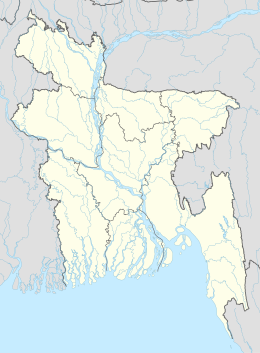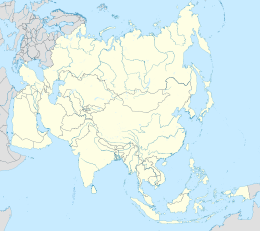
Back Chittagong ACE Chittagong Afrikaans ቻቶግራም Amharic Chittagong AN جاتجام Arabic شيتاجونج ARZ চট্টগ্ৰাম Assamese Chittagong AST Çittaqonq Azerbaijani Čėtagons BAT-SMG
Chittagong
| |
|---|---|
| Chattogram | |
| Nickname(s): | |
| Coordinates: 22°20′06″N 91°49′57″E / 22.33500°N 91.83250°E | |
| Country | |
| Division | Chittagong |
| District | Chittagong |
| Establishment | 1340 |
| Granted city status | 1863[2] |
| Government | |
| • Type | Mayor–Council |
| • Body | Chattogram City Corporation |
| • Mayor | Shahadat Hossain (BNP) |
| • Police Commissioner | Md. Hasib Aziz, BPM (Bar) |
| Area | |
| 168.07 km2 (64.89 sq mi) | |
| • Urban | 272.03 km2 (105.03 sq mi) |
| • Metro | 655.74 km2 (253.18 sq mi) |
| Elevation | 29 m (95 ft) |
| Population (2022) | |
| 3,230,507 | |
| • Density | 32,008/km2 (82,900/sq mi) |
| • Metro | 5,513,609[4] |
| • City rank | 2nd in Bangladesh |
| • Metro rank | 2nd in Bangladesh; 3rd in Bengal Region; |
| Demonym(s) | Chittagonian, Chatgaiya, Chottola |
| Languages | |
| • Official | Bengali • English |
| • Native | Chittagonian |
| Religion (2022) | |
| • Religion | |
| Time zone | UTC+6 (BST) |
| Postal code | 4000, 4100, 42xx |
| Calling code | +880 31 |
| UN/LOCODE | BD CGP |
| GDP[6] | PPP Nominal |
| HDI (2022) | 0.695[7] medium · 3rd of 20 |
| Police | Chattogram Metropolitan Police |
| International Airport | Shah Amanat International Airport |
| Metropolitan Planning Authority | Chittagong Development Authority |
| Water Supply and Sewerage Authority | Chattogram WASA |
| Website | ccc.gov.bd |
Chittagong (/ˈtʃɪtəɡɒŋ/ CHIT-ə-gong),[8] officially Chattogram,[9] (Bengali: চট্টগ্রাম, romanized: Côṭṭôgrām, IPA: [ˈt͡ʃɔʈːoɡram]) (Chittagonian: চাটগাঁও, romanized: Sāṭgão, or চিটাং, Siṭāṅ) is the second-largest city in Bangladesh. Home to the Port of Chittagong, it is the busiest port in Bangladesh and the Bay of Bengal.[10] The city is also known as business capital of Bangladesh. It is the administrative seat of an eponymous division and district. The city is located on the banks of the Karnaphuli River between the Chittagong Hill Tracts and the Bay of Bengal. The Greater Chittagong Area had a population of more than 140 million in 2022. In 2022, the Chittagong District had a population of approx 9.2 Million according to a census conducted by Government of Bangladesh.[11] In 2022, the city area had a population of more than 5.6 million.[12] The city is home to many large local businesses and plays an important role in the Bangladeshi economy.
One of the world's oldest ports with a functional natural harbor for centuries,[13] Chittagong appeared on ancient Greek and Roman maps, including on Ptolemy's world map. It was located on the southern branch of the Silk Road. In the 9th century, merchants from the Abbasid Caliphate established a trading post in Chittagong.[14][15] The port fell to the Muslim conquest of Bengal during the 14th century. It was the site of a royal mint under the Delhi Sultanate, Bengal Sultanate and Mughal Empire.[16] Between the 15th and 17th centuries, Chittagong was also a center of administrative, literary, commercial and maritime activities in Arakan, a narrow strip of land along the eastern coast of the Bay of Bengal which was under strong Bengali influence for 350 years. During the 16th century, the port became a Portuguese trading post and João de Barros described it as "the most famous and wealthy city of the Kingdom of Bengal".[17] The Mughal Empire expelled the Portuguese and Arakanese in 1666.
The Nawab of Bengal ceded the port to the British East India Company in 1793. The Port of Chittagong was re-organized in 1887 and its busiest shipping links were with British Burma. In 1928, Chittagong was declared a "Major Port" of British India. During World War II, Chittagong was a base for Allied Forces engaged in the Burma Campaign. The port city began to expand and industrialize during the 1940s, particularly after the Partition of British India. The city was the historic terminus of the Assam Bengal Railway and Pakistan Eastern Railway. During the Bangladesh Liberation War in 1971, Chittagong was the site of the Bangladeshi declaration of independence. The port city has benefited from the growth of heavy industry, logistics, and manufacturing in Bangladesh. Trade unionism was strong during the 1990s.
Chittagong accounts for 12% of Bangladesh's GDP, including 40% of industrial output, 80% of international trade, and 50% of tax revenue. The port city is home to many of the oldest and largest companies in the country. The Port of Chittagong is one of the busiest ports in South Asia. The largest base of the Bangladesh Navy is located in Chittagong, along with an air base of the Bangladesh Air Force, garrisons of the Bangladesh Army and the main base of the Bangladesh Coast Guard. The eastern zone of the Bangladesh Railway is based in Chittagong. The Chittagong Stock Exchange is one of the twin stock markets of Bangladesh with over 700 listed companies. The Chittagong Tea Auction is a commodity exchange dealing with Bangladeshi tea. The CEPZ and KEPZ are key industrial zones with foreign direct investments. The city is served by Shah Amanat International Airport for domestic and external flights. Bangabandhu Sheikh Mujibur Rahman Tunnel, the first and only underwater road tunnel of South Asia, is located in Chittagong. The city is the hometown of prominent economists, a Nobel laureate, scientists, freedom fighters and entrepreneurs. Chittagong has a high degree of religious and ethnic diversity among Bangladeshi cities, despite having a great Muslim majority. Minorities include Hindus, Christians, Buddhists, Chakmas, Marmas, Tripuris, Garos and others.
- ^ "Protect the Queen of the East". The Daily Star. 10 July 2017. Retrieved 3 September 2021.
- ^ "History of Chittagong City Corporation". Chittagong City Corporation. Archived from the original on 13 August 2013. Retrieved 26 May 2013.
- ^ "Area, Population and Literacy Rate by Paurashava −2001" (PDF). Bangladesh Bureau of Statistics. Archived from the original (PDF) on 10 June 2007. Retrieved 18 September 2009.
- ^ "Chittagong Population 2024". World Population Review. Retrieved 14 May 2024.
- ^ "বাংলাদেশ পরিসংখ্যান ব্যুরো".
- ^ "TelluBase—Dhaka Fact Sheet (Tellusant Public Service Series)" (PDF). Retrieved 10 October 2024.
- ^ "Sub-national HDI – Area Database – Global Data Lab". hdi.globaldatalab.org. Retrieved 11 July 2021.
- ^ "Definition of Chittagong". Dictionary.com. Retrieved 23 February 2022.
- ^ Cite error: The named reference
dt2Apr2018was invoked but never defined (see the help page). - ^ Cite error: The named reference
thedailystar.netwas invoked but never defined (see the help page). - ^ "Chittagong · Population". population.city. Retrieved 30 April 2022.
- ^ "Bangladesh: Districts and Cities - Population Statistics, Maps, Charts, Weather and Web Information". www.citypopulation.de. Retrieved 31 August 2024.
- ^ Ring, Trudy; Watson, Noelle; Schellinger, Paul (12 November 2012). Asia and Oceania: International Dictionary of Historic Places. Routledge. ISBN 978-1-136-63979-1.
- ^ Cite error: The named reference
bp-arabswas invoked but never defined (see the help page). - ^ Islam, Shariful; Hoque, Muhammad Manirul. "Unpublished Umayyad and Abbasid Silver Coins in the Bangladesh National Museum" (PDF). Journal of the Asiatic Society of Bangladesh (Hum.). 62 (2): 205–231. Archived from the original (PDF) on 9 October 2022. Retrieved 9 March 2022.
- ^ "Mint Towns". Banglapedia. 5 August 2021. Retrieved 16 March 2022.
- ^ "Chittagong | History, Population, & Facts". Encyclopædia Britannica. Retrieved 23 February 2022.








